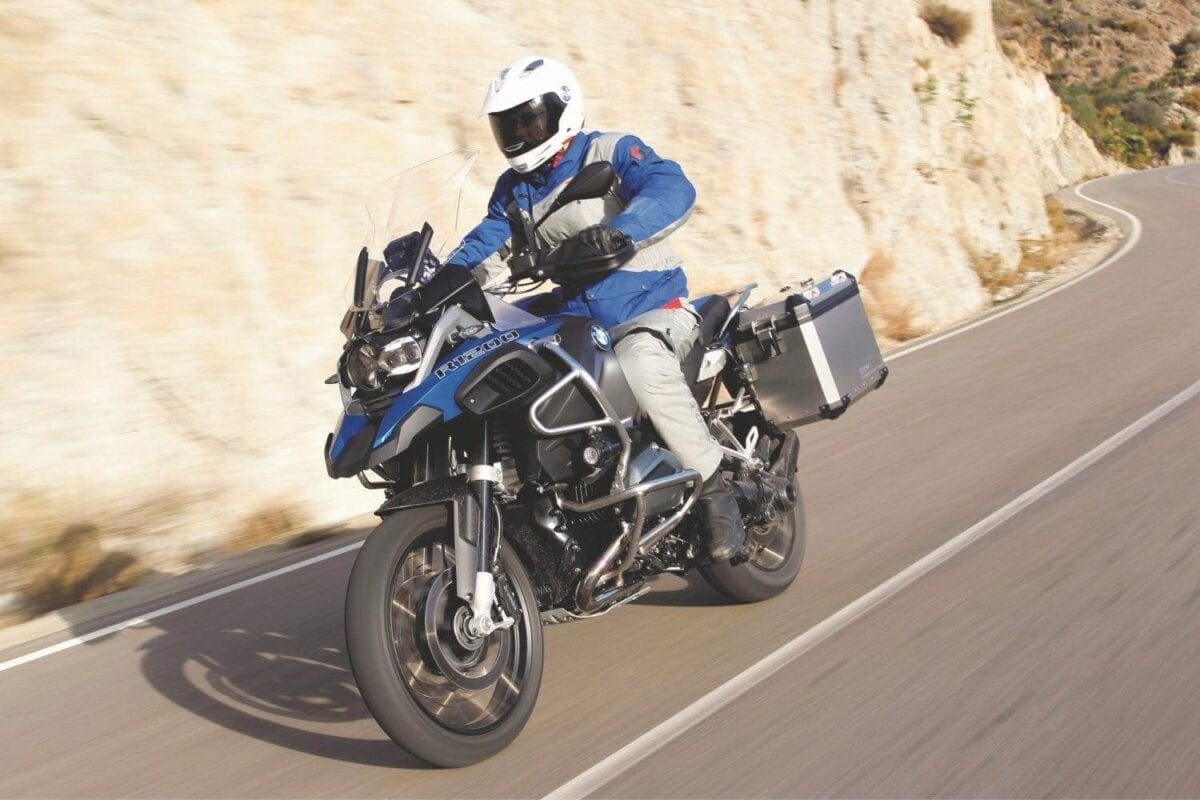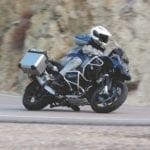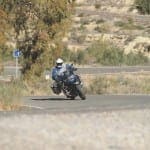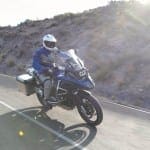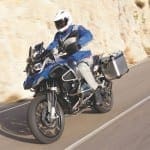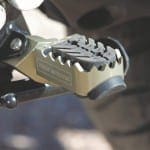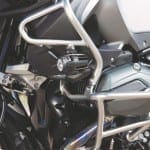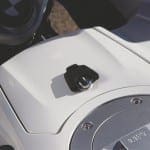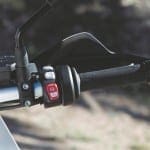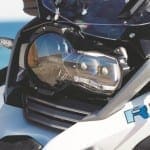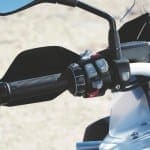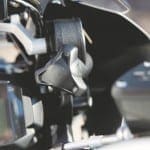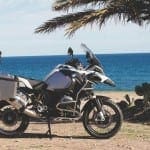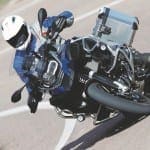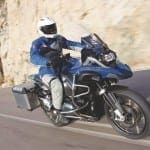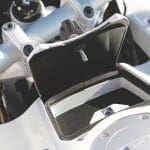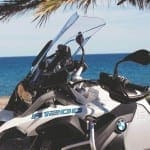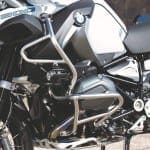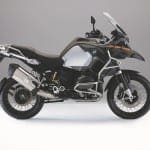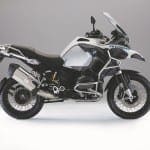£14,765 | 125bhp@7750rpm | 92lb-ft@6500rpm | liquid-cooled boxer twin
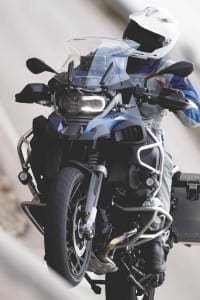 There’s an obvious problem in trying to evaluate this updated R1200GS Adventure following a launch ride that was done and dusted in time for lunch. But then again, even a week-long tour would hardly do justice to a boxer that was designed to circumnavigate the globe — heavily loaded, and coping with river, mountain and desert crossings, plus possibly spills and bandits (if not TV crews) along the way.
There’s an obvious problem in trying to evaluate this updated R1200GS Adventure following a launch ride that was done and dusted in time for lunch. But then again, even a week-long tour would hardly do justice to a boxer that was designed to circumnavigate the globe — heavily loaded, and coping with river, mountain and desert crossings, plus possibly spills and bandits (if not TV crews) along the way.
In some ways this Adventure is even more purposeful than its predecessor, as the model’s sales success in recent years has given BMW the incentive to give it a more thorough overhaul than simply equipping it with the more powerful, liquid-cooled boxer motor that was introduced on the standard R1200GS a year ago.
That motor is tweaked, bodywork and the trademark super-large fuel tank are refreshed, and the chassis is thoroughly overhauled to match the standard GS with the option of semi-active damping for the long-travel suspension. It’s a major update for a giant bike that was already one of motorcycling’s biggest and most improbable hits.
Tell me about the engine
The 1170cc, DOHC motor differs from the standard GS unit by having a 950g heavier flywheel for smoother delivery at low revs. There’s also an extra vibration damper between gearbox and drive shaft. In other respects the radial eight-valve unit is identical, as is its maximum output of 125bhp at 7750rpm. Like the standard GS, the Adventure comes with ASC (Automatic Stability 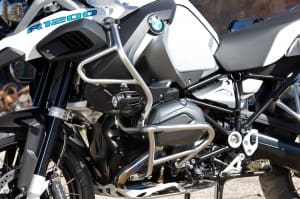 Control) traction control, plus choice of riding modes. The basic Adventure gets the normal Road mode plus Rain, which softens delivery to the same peak output.
Control) traction control, plus choice of riding modes. The basic Adventure gets the normal Road mode plus Rain, which softens delivery to the same peak output.
There’s also an option of an upgrade to Riding Mode Pro, included with the higher spec Adventure XE and TE models. As with the stock GS this gives three extra riding modes: Dynamic, Enduro and Enduro Pro, the latter requiring a plug under the seat. As with the standard GS, the riding mode also controls the optional semi-active suspension system, Dynamic ESA (Electronic Suspension Adjustment), which is included with the TE and XE models.
What’s the chassis like?
Most differences from the standard GS echo those of the previous Adventure, including the 30-litre petrol tank whose extra 10 litres’ capacity is a 50 per cent increase. This Adventure’s aluminium tank is 4kg lighter and three litres smaller than the old model’s plastic tank, having gained a small lockable storage area near the filler cap. At my easily bettered 40mpg average it’s good for a realistic range of over 250 miles.
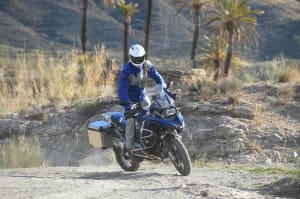 The suspension’s giraffe-like 210mm of front and 220mm of rear travel give a 20mm advantage over the standard GS. The Telelever front suspension system’s geometry is revised for sharper handling, and the Adventure follows the standard boxer in gaining a steering damper (possibly in response to reports of occasional tank-slappers) plus Dynamic ESA semi-active suspension on the higher spec models.
The suspension’s giraffe-like 210mm of front and 220mm of rear travel give a 20mm advantage over the standard GS. The Telelever front suspension system’s geometry is revised for sharper handling, and the Adventure follows the standard boxer in gaining a steering damper (possibly in response to reports of occasional tank-slappers) plus Dynamic ESA semi-active suspension on the higher spec models.
As before the screen is larger than the standard GS’s. Bodywork is revamped, incorporating a prominent beak, and protected by a tubular steel crash-bar. There’s also an aluminium bash-plate. At 890 or 910mm, the quickly height-adjustable seat is 40mm taller than the stock bike’s, although compared to the previous Adventure it’s unchanged in height and slightly narrower at the front, making reaching the ground easier. Footrests are wide, serrated items with adjustable, reinforced levers.
Should I buy one?
If you’re planning to ride half-way around the world, especially two-up, the GS Adventure has long been the default choice, and this bike is better than ever. It’s big and heavy, especially when loaded; and it’s expensive, particularly when kitted out with accessories. But provided you’re physically able to cope with a bike of the Adventure’s size, its performance, comfort and ruggedness make it hard to beat.
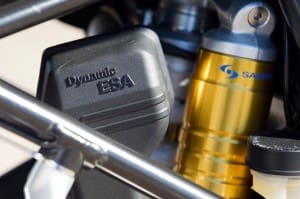 On the other hand, if in reality you’ll rarely ride far, let alone far off-road, you’d probably be better off with a standard R1200GS or even a smaller, more manageable alternative. The standard Adventure costs £12,600 on the road, roughly a grand more than the standard GS, but 95 per cent of buyers opt for the top-spec TE version, as tested on the launch.
On the other hand, if in reality you’ll rarely ride far, let alone far off-road, you’d probably be better off with a standard R1200GS or even a smaller, more manageable alternative. The standard Adventure costs £12,600 on the road, roughly a grand more than the standard GS, but 95 per cent of buyers opt for the top-spec TE version, as tested on the launch.
The TE includes hot grips, Dynamic ESA suspension, off-road riding modes, cruise control, running lights, uprated instruments and pannier fittings, and costs £14,765 — before you add the panniers. If you’re heading for Siberia’s Road of Bones or just want to own the toughest two-wheeled Tonka toy, even if you’ll barely scratch the surface of its ability, then don’t let us put you off.
So what’s it like to ride?
It feels big even if you’re tall. Simply throwing a leg over that seat is a struggle for shorter riders, as is getting the bike off its centre-stand. Despite BMW’s efforts at weight reduction it’s still 260kg wet, of which almost 20kg is fuel. But it does have an impressive ability to shed its weight on the move, and the power delivery is very controllable.
 As with the standard GS, the more powerful, liquid-cooled engine makes a notable difference over the previous model. The old DOHC, eight-valve motor is punchy and respectably powerful. But this bike’s extra urgency of throttle response, stronger midrange delivery and especially its smoother, more rev-happy charge to a 500rpm higher redline at 9000rpm combine to make the BMW faster and more fun.
As with the standard GS, the more powerful, liquid-cooled engine makes a notable difference over the previous model. The old DOHC, eight-valve motor is punchy and respectably powerful. But this bike’s extra urgency of throttle response, stronger midrange delivery and especially its smoother, more rev-happy charge to a 500rpm higher redline at 9000rpm combine to make the BMW faster and more fun.
The big bike is now even more rapid than ever, effortlessly able to keep up three-figure cruising speeds, and accelerate towards a top speed of over 130mph given a tweak of throttle. Yet there’s no shortage of low-rev performance. In top gear the TE pulled cleanly and smoothly from 3000rpm and about 50mph, and sat happily at an indicated 80rpm with its cruise control making life even more relaxed.
As before the Adventure has an edge over the standard GS for long distances due to its larger screen. This is now even bigger, and did a better job of keeping lanky me out of the turbulence. The Adventure borrows the standard GS’s excellent screw-adjuster, which can be used on the move with a twist of left hand. At speed I sometimes found the knob wouldn’t turn, presumably due to friction from wind pressure because it normally worked fine.
The Adventure’s beak has been redesigned for extra downforce. At high speed in a straight line and when carving through fast main-road curves the bike felt slightly vague, but never remotely concerning. At slower speeds it was remarkably taut, especially when I switched to Dynamic riding mode, which firms-up the semi-active suspension as well as the throttle response.
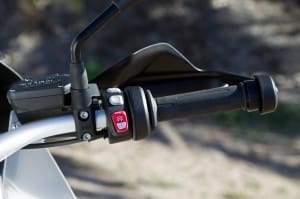 Dynamic ESA is arguably at its most useful on a bike with lots of suspension travel, given the semi-active system’s ability to stiffen or soften the damping at either end, depending on speed, surface and how hard you’re accelerating or slowing. Even fierce braking didn’t faze it. The Brembo radial four-piston front calipers bit hard, also adding some rear brake due to the linked system, and were backed up by an excellent ABS. The road biased Michelin Anakee III tyres coped well too.
Dynamic ESA is arguably at its most useful on a bike with lots of suspension travel, given the semi-active system’s ability to stiffen or soften the damping at either end, depending on speed, surface and how hard you’re accelerating or slowing. Even fierce braking didn’t faze it. The Brembo radial four-piston front calipers bit hard, also adding some rear brake due to the linked system, and were backed up by an excellent ABS. The road biased Michelin Anakee III tyres coped well too.
When the road turned into a dirt track the Adventure TE merely required a press of the button into Enduro mode to soften its suspension and retune the ABS and traction control to suit, before sliding along enjoyably on the loose surface, the electronics doing a good job of helping keep it under control. With a fairly full tank I did notice the extra weight over the standard GS but the Adventure was remarkably capable.
We didn’t have time to adjust the handlebar, which was too low for me, but that’s hardly a major complaint. This thoughtfully updated boxer wasn’t created to be constrained by launch budgets and deadlines. It was built for loading up and setting off to who knows where, for who cares how long. Provided you can cope with its size, there’s probably no better bike for doing just that.
Tested by: Roland Brown Photos by: Arnold Debus, Jörg Künstl and Peter Musch
TECH SPEC
Price: £14,765
Engine: 1170cc liquid-cooled DOHC boxer twin, 4 valves
Power: 125bhp (93kW)@7750rpm
Torque: 92lb-ft (125Nm)@6500rpm
Curb weight: 260kg
Seat height: 890-910mm
Tank size: 30 litres

